With 的复合宾语结构及分词的独立主格结构
- 格式:doc
- 大小:45.00 KB
- 文档页数:4
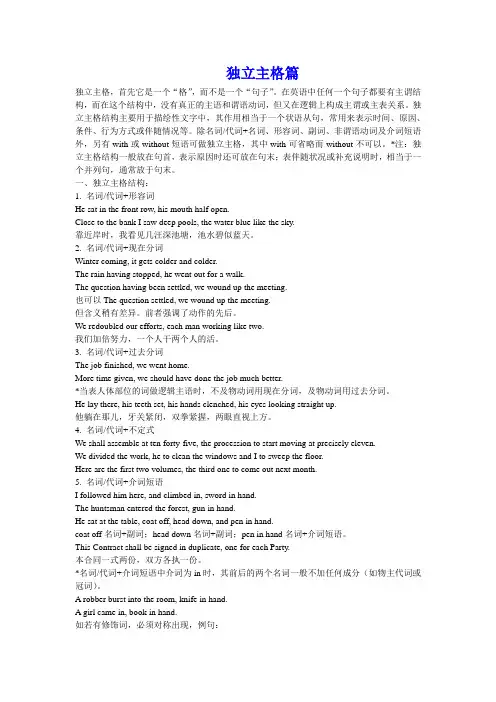
独立主格篇独立主格,首先它是一个“格”,而不是一个“句子”。
在英语中任何一个句子都要有主谓结构,而在这个结构中,没有真正的主语和谓语动词,但又在逻辑上构成主谓或主表关系。
独立主格结构主要用于描绘性文字中,其作用相当于一个状语从句,常用来表示时间、原因、条件、行为方式或伴随情况等。
除名词/代词+名词、形容词、副词、非谓语动词及介词短语外,另有with或without短语可做独立主格,其中with可省略而without不可以。
*注:独立主格结构一般放在句首,表示原因时还可放在句末;表伴随状况或补充说明时,相当于一个并列句,通常放于句末。
一、独立主格结构:1. 名词/代词+形容词He sat in the front row, his mouth half open.Close to the bank I saw deep pools, the water blue like the sky.靠近岸时,我看见几汪深池塘,池水碧似蓝天。
2. 名词/代词+现在分词Winter coming, it gets colder and colder.The rain having stopped, he went out for a walk.The question having been settled, we wound up the meeting.也可以The question settled, we wound up the meeting.但含义稍有差异。
前者强调了动作的先后。
We redoubled our efforts, each man working like two.我们加倍努力,一个人干两个人的活。
3. 名词/代词+过去分词The job finished, we went home.More time given, we should have done the job much better.*当表人体部位的词做逻辑主语时,不及物动词用现在分词,及物动词用过去分词。
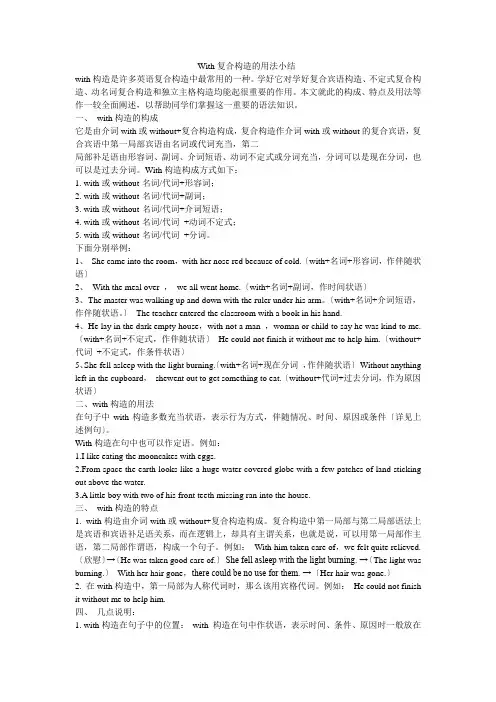
With复合构造的用法小结with构造是许多英语复合构造中最常用的一种。
学好它对学好复合宾语构造、不定式复合构造、动名词复合构造和独立主格构造均能起很重要的作用。
本文就此的构成、特点及用法等作一较全面阐述,以帮助同学们掌握这一重要的语法知识。
一、with构造的构成它是由介词with或without+复合构造构成,复合构造作介词with或without的复合宾语,复合宾语中第一局部宾语由名词或代词充当,第二局部补足语由形容词、副词、介词短语、动词不定式或分词充当,分词可以是现在分词,也可以是过去分词。
With构造构成方式如下:1. with或without-名词/代词+形容词;2. with或without-名词/代词+副词;3. with或without-名词/代词+介词短语;4. with或without-名词/代词+动词不定式;5. with或without-名词/代词+分词。
下面分别举例:1、She came into the room,with her nose red because of cold.〔with+名词+形容词,作伴随状语〕2、With the meal over ,we all went home.〔with+名词+副词,作时间状语〕3、The master was walking up and down with the ruler under his arm。
〔with+名词+介词短语,作伴随状语。
〕The teacher entered the classroom with a book in his hand.4、He lay in the dark empty house,with not a man ,woman or child to say he was kind to me.〔with+名词+不定式,作伴随状语〕He could not finish it without me to help him.〔without+代词+不定式,作条件状语〕5、She fell asleep with the light burning.〔with+名词+现在分词,作伴随状语〕Without anything left in the cupboard,shewent out to get something to eat.〔without+代词+过去分词,作为原因状语〕二、with构造的用法在句子中with构造多数充当状语,表示行为方式,伴随情况、时间、原因或条件〔详见上述例句〕。
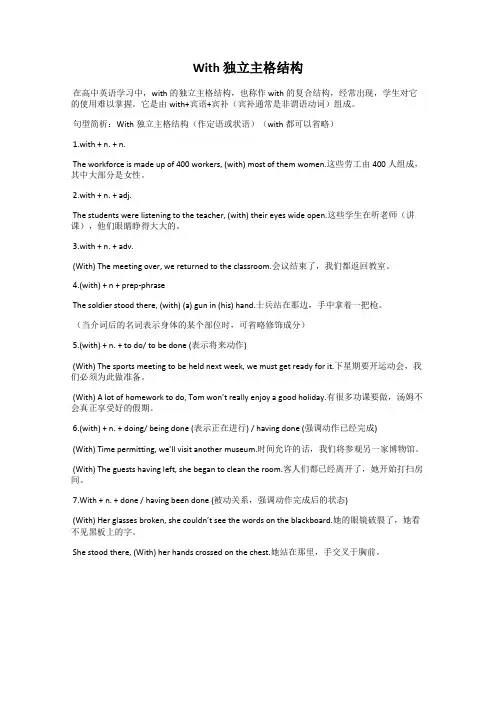
With 独立主格结构在高中英语学习中,with的独立主格结构,也称作with的复合结构,经常出现,学生对它的使用难以掌握。
它是由with+宾语+宾补(宾补通常是非谓语动词)组成。
句型简析:With独立主格结构(作定语或状语)(with都可以省略)1.with + n. + n.The workforce is made up of 400 workers, (with) most of them women.这些劳工由400人组成,其中大部分是女性。
2.with + n. + adj.The students were listening to the teacher, (with) their eyes wide open.这些学生在听老师(讲课),他们眼睛睁得大大的。
3.with + n. + adv.(With) The meeting over, we returned to the classroom.会议结束了,我们都返回教室。
4.(with) + n + prep-phraseThe soldier stood there, (with) (a) gun in (his) hand.士兵站在那边,手中拿着一把枪。
(当介词后的名词表示身体的某个部位时,可省略修饰成分)5.(with) + n. + to do/ to be done (表示将来动作)(With) The sports meeting to be held next week, we must get ready for it.下星期要开运动会,我们必须为此做准备。
(With) A lot of homework to do, Tom won’t really enjo y a good holiday.有很多功课要做,汤姆不会真正享受好的假期。
6.(with) + n. + doing/ being done (表示正在进行) / having done (强调动作已经完成)(With) Time permitting, we’ll visit another museum.时间允许的话,我们将参观另一家博物馆。
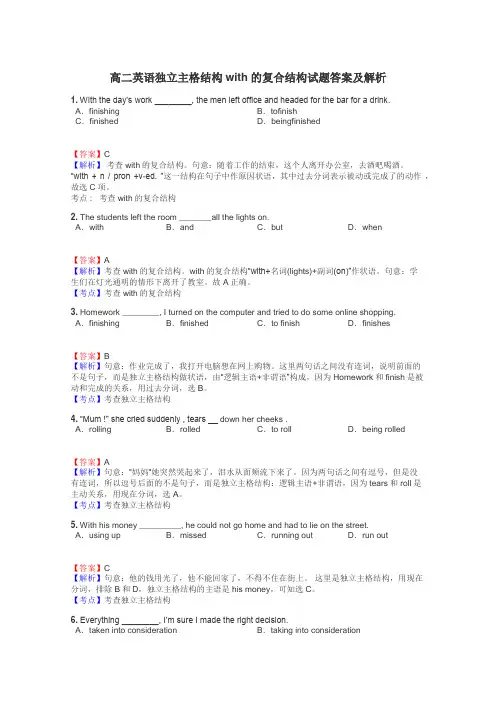
高二英语独立主格结构with的复合结构试题答案及解析1.With the day’s work ________, the men left office and headed for the bar for a drink. A.finishing B.tofinishC.finished D.beingfinished【答案】C【解析】考查with的复合结构。
句意:随着工作的结束,这个人离开办公室,去酒吧喝酒。
“with + n / pron +v-ed. ”这一结构在句子中作原因状语,其中过去分词表示被动或完成了的动作,故选C项。
考点 : 考查with的复合结构2. The students left the room _______all the lights on.A.with B.and C.but D.when【答案】A【解析】考查with的复合结构。
with的复合结构“with+名词(lights)+副词(on)”作状语。
句意:学生们在灯光通明的情形下离开了教室。
故A正确。
【考点】考查with的复合结构3. Homework ________, I turned on the computer and tried to do some online shopping. A.finishing B.finished C.to finish D.finishes【答案】B【解析】句意:作业完成了,我打开电脑想在网上购物。
这里两句话之间没有连词,说明前面的不是句子,而是独立主格结构做状语,由“逻辑主语+非谓语”构成,因为Homework和finish是被动和完成的关系,用过去分词,选B。
【考点】考查独立主格结构4.“Mum !” she cried suddenly , tears down her cheeks .A.rolling B.rolled C.to roll D.being rolled【答案】A【解析】句意:“妈妈“她突然哭起来了,泪水从面颊流下来了。
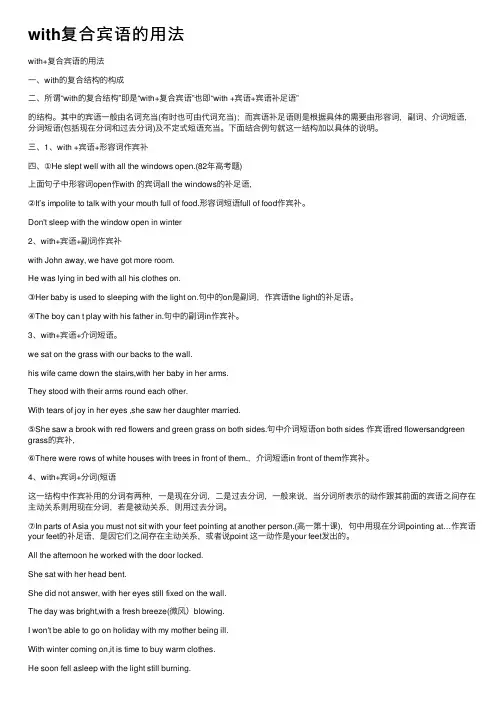
with复合宾语的⽤法with+复合宾语的⽤法⼀、with的复合结构的构成⼆、所谓“with的复合结构”即是“with+复合宾语”也即“with +宾语+宾语补⾜语”的结构。
其中的宾语⼀般由名词充当(有时也可由代词充当);⽽宾语补⾜语则是根据具体的需要由形容词,副词、介词短语,分词短语(包括现在分词和过去分词)及不定式短语充当。
下⾯结合例句就这⼀结构加以具体的说明。
三、1、with +宾语+形容词作宾补四、①He slept well with all the windows open.(82年⾼考题)上⾯句⼦中形容词open作with 的宾词all the windows的补⾜语,②It’s impolite to talk with your mouth full of food.形容词短语full of food作宾补。
Don't sleep with the window open in winter2、with+宾语+副词作宾补with John away, we have got more room.He was lying in bed with all his clothes on.③Her baby is used to sleeping with the light on.句中的on是副词,作宾语the light的补⾜语。
④The boy can t play with his father in.句中的副词in作宾补。
3、with+宾语+介词短语。
we sat on the grass with our backs to the wall.his wife came down the stairs,with her baby in her arms.They stood with their arms round each other.With tears of joy in her eyes ,she saw her daughter married.⑤She saw a brook with red flowers and green grass on both sides.句中介词短语on both sides 作宾语red flowersandgreen grass的宾补,⑥There were rows of white houses with trees in front of them.,介词短语in front of them作宾补。
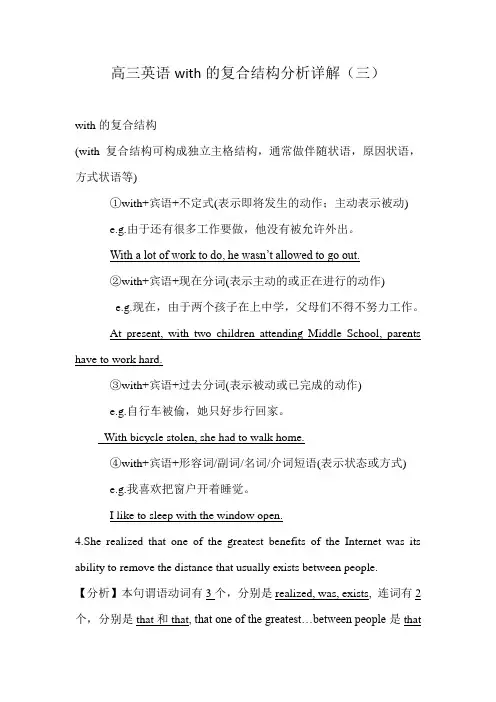
高三英语with的复合结构分析详解(三)with的复合结构(with复合结构可构成独立主格结构,通常做伴随状语,原因状语,方式状语等)①with+宾语+不定式(表示即将发生的动作;主动表示被动)e.g.由于还有很多工作要做,他没有被允许外出。
With a lot of work to do, he wasn’t allowed to go out.②with+宾语+现在分词(表示主动的或正在进行的动作)e.g.现在,由于两个孩子在上中学,父母们不得不努力工作。
At present, with two children attending Middle School, parents have to work hard.③with+宾语+过去分词(表示被动或已完成的动作)e.g.自行车被偷,她只好步行回家。
With bicycle stolen, she had to walk home.④with+宾语+形容词/副词/名词/介词短语(表示状态或方式)e.g.我喜欢把窗户开着睡觉。
I like to sleep with the window open.4.She realized that one of the greatest benefits of the Internet was its ability to remove the distance that usually exists between people.【分析】本句谓语动词有3个,分别是realized, was, exists, 连词有2个,分别是that和that, that one of the greatest…between people是that引导的宾语从句,做realized的宾语,to remove the distance 是不定式短语做后置定语,修饰its ability,构成the ability to do sth.的结构,意为做某事的能力,此外,该从句还包含了that引导的定语从句(that usually exists between people),修饰先行词the distance,指物(人/物),that 在从句中做主语。
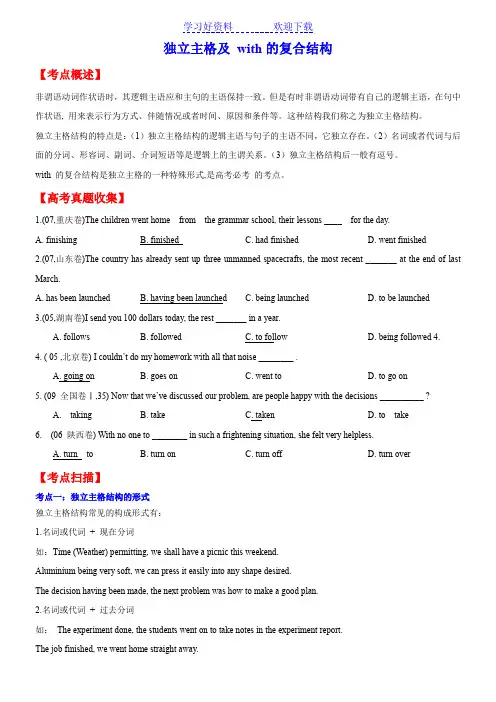
独立主格及with的复合结构【考点概述】非谓语动词作状语时,其逻辑主语应和主句的主语保持一致。
但是有时非谓语动词带有自己的逻辑主语,在句中作状语, 用来表示行为方式、伴随情况或者时间、原因和条件等。
这种结构我们称之为独立主格结构。
独立主格结构的特点是:(1)独立主格结构的逻辑主语与句子的主语不同,它独立存在。
(2)名词或者代词与后面的分词、形容词、副词、介词短语等是逻辑上的主谓关系。
(3)独立主格结构后一般有逗号。
with 的复合结构是独立主格的一种特殊形式,是高考必考的考点。
【高考真题收集】1.(07,重庆卷)The children went home from the grammar school, their lessons ____ for the day.A. finishingB. finishedC. had finishedD. went finished2.(07,山东卷)The country has already sent up three unmanned spacecrafts, the most recent _______ at the end of last March.A. has been launchedB. having been launchedC. being launchedD. to be launched3.(05,湖南卷)I send you 100 dollars today, the rest _______ in a year.A. followsB. followedC. to followD. being followed 4.4. ( 05 ,北京卷) I couldn’t do my homework with all that noise ________ .A. going onB. goes onC. went toD. to go on5. (09 全国卷Ⅰ,35) Now that we’ve discussed our problem, are people happy with the decisions __________ ?A. takingB. takeC. takenD. to take6. (06 陕西卷) With no one to ________ in such a frightening situation, she felt very helpless.A. turn toB. turn onC. turn offD. turn over【考点扫描】考点一:独立主格结构的形式独立主格结构常见的构成形式有:1.名词或代词+ 现在分词如:Time (Weather) permitting, we shall have a picnic this weekend.Aluminium being very soft, we can press it easily into any shape desired.The decision having been made, the next problem was how to make a good plan.2.名词或代词+ 过去分词如:The experiment done, the students went on to take notes in the experiment report.The job finished, we went home straight away.The sum added, we’ll have enough money for the trip.注意:用现在分词还是过去分词,要看前面的名词或代词与后面动词的关系。
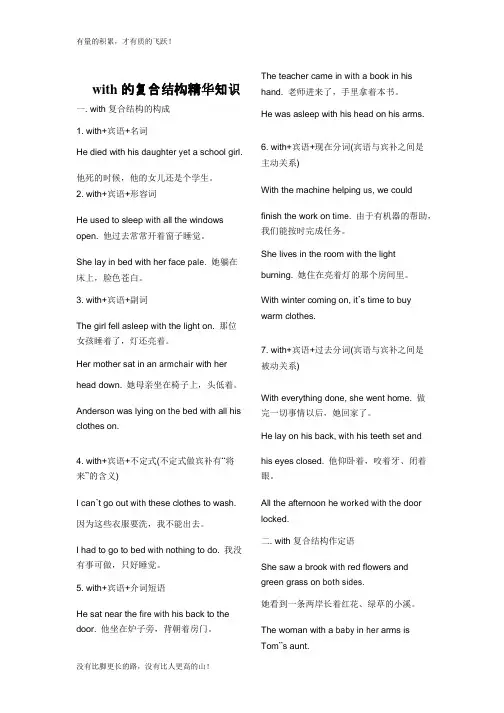
with 的复合结构精华知识一. with复合结构的构成1. with+宾语+名词He died with his daughter yet a school girl.他死的时候,他的女儿还是个学生。
2. with+宾语+形容词He used to sleep with all the windows open. 他过去常常开着窗子睡觉。
She lay in bed with her face pale.她躺在床上,脸色苍白。
3. with+宾语+副词The girl fell asleep with the light on. 那位女孩睡着了,灯还亮着。
Her mother sat in an armchair with her head down. 她母亲坐在椅子上,头低着。
Anderson was lying on the bed with all his clothes on.4. with+宾语+不定式(不定式做宾补有“将来”的含义)I can’t go out with these clothes to wash.因为这些衣服要洗,我不能出去。
I had to go to bed with nothing to do. 我没有事可做,只好睡觉。
5. with+宾语+介词短语He sat near the fire with his back to the door. 他坐在炉子旁,背朝着房门。
The teacher came in with a book in his hand. 老师进来了,手里拿着本书。
He was asleep with his head on his arms.6. with+宾语+现在分词(宾语与宾补之间是主动关系)With the machine helping us,we couldfinish the work on time.由于有机器的帮助,我们能按时完成任务。
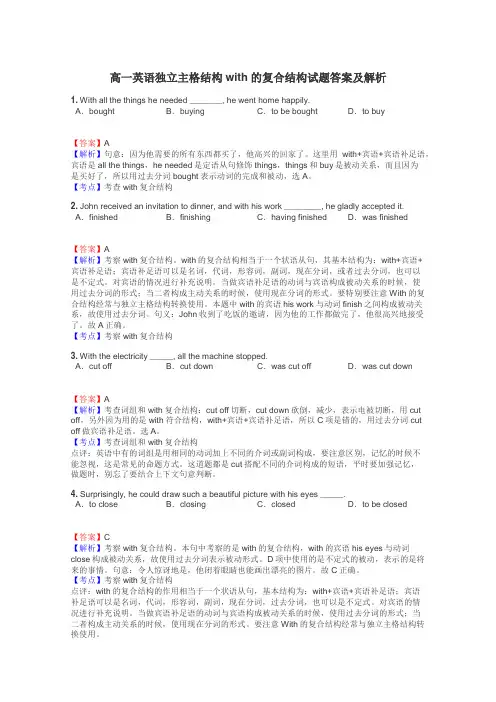
高一英语独立主格结构with的复合结构试题答案及解析1. With all the things he needed _______, he went home happily.A.bought B.buying C.to be bought D.to buy【答案】A【解析】句意:因为他需要的所有东西都买了,他高兴的回家了。
这里用with+宾语+宾语补足语,宾语是all the things,he needed是定语从句修饰things,things和buy是被动关系,而且因为是买好了,所以用过去分词bought表示动词的完成和被动,选A。
【考点】考查with复合结构2. John received an invitation to dinner, and with his work ________, he gladly accepted it. A.finished B.finishing C.having finished D.was finished【答案】A【解析】考察with复合结构。
with的复合结构相当于一个状语从句,其基本结构为:with+宾语+宾语补足语;宾语补足语可以是名词,代词,形容词,副词,现在分词,或者过去分词,也可以是不定式。
对宾语的情况进行补充说明。
当做宾语补足语的动词与宾语构成被动关系的时候,使用过去分词的形式;当二者构成主动关系的时候,使用现在分词的形式。
要特别要注意With的复合结构经常与独立主格结构转换使用。
本题中with的宾语his work与动词finish之间构成被动关系,故使用过去分词。
句义:John收到了吃饭的邀请,因为他的工作都做完了,他很高兴地接受了。
故A正确。
【考点】考察with复合结构3. With the electricity _____, all the machine stopped.A.cut off B.cut down C.was cut off D.was cut down【答案】A【解析】考查词组和with复合结构:cut off切断,cut down砍倒,减少,表示电被切断,用cut off,另外因为用的是with符合结构,with+宾语+宾语补足语,所以C项是错的,用过去分词cut off做宾语补足语。

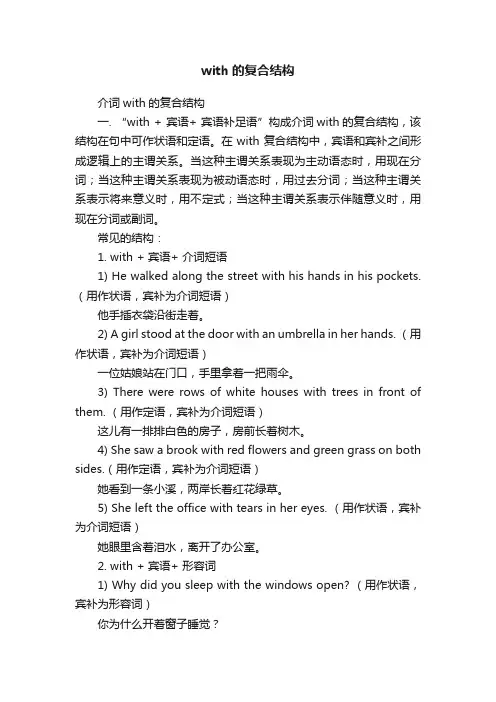
with的复合结构介词with的复合结构一. “with + 宾语+ 宾语补足语”构成介词with的复合结构,该结构在句中可作状语和定语。
在with复合结构中,宾语和宾补之间形成逻辑上的主谓关系。
当这种主谓关系表现为主动语态时,用现在分词;当这种主谓关系表现为被动语态时,用过去分词;当这种主谓关系表示将来意义时,用不定式;当这种主谓关系表示伴随意义时,用现在分词或副词。
常见的结构:1. with + 宾语+ 介词短语1) He walked along the street with his hands in his pockets. (用作状语,宾补为介词短语)他手插衣袋沿街走着。
2) A girl stood at the door with an umbrella in her hands. (用作状语,宾补为介词短语)一位姑娘站在门口,手里拿着一把雨伞。
3) There were rows of white houses with trees in front of them. (用作定语,宾补为介词短语)这儿有一排排白色的房子,房前长着树木。
4) She saw a brook with red flowers and green grass on both sides.(用作定语,宾补为介词短语)她看到一条小溪,两岸长着红花绿草。
5) She left the office with tears in her eyes. (用作状语,宾补为介词短语)她眼里含着泪水,离开了办公室。
2. with + 宾语+ 形容词1) Why did you sleep with the windows open? (用作状语,宾补为形容词)你为什么开着窗子睡觉?2) She sat down with her face pale with pain. (作状语,宾补为形容词)她坐下来,痛的脸色发白了。
高一英语独立主格结构with的复合结构试题答案及解析1. John received an invitation to dinner, and with his work ________, he gladly accepted it. A.finished B.finishing C.having finished D.was finished【答案】A【解析】考察with复合结构。
with的复合结构相当于一个状语从句,其基本结构为:with+宾语+宾语补足语;宾语补足语可以是名词,代词,形容词,副词,现在分词,或者过去分词,也可以是不定式。
对宾语的情况进行补充说明。
当做宾语补足语的动词与宾语构成被动关系的时候,使用过去分词的形式;当二者构成主动关系的时候,使用现在分词的形式。
要特别要注意With的复合结构经常与独立主格结构转换使用。
本题中with的宾语his work与动词finish之间构成被动关系,故使用过去分词。
句义:John收到了吃饭的邀请,因为他的工作都做完了,他很高兴地接受了。
故A正确。
【考点】考察with复合结构2. lots of trees and flowers planted everywhere, the city looks more beautiful.A.As B.For C.With D.Though【答案】C【解析】考查with复合结构:句意:随着到处种了很多的树和花,这个城市看起来更加美丽了。
注意这里的planted不是谓语,因为如果是谓语应该是are planted,所以这是过去分词,也就是不是一个简单句,而ABD三个选项都是连词,只有with复合结构是“with+宾语+过去分词”,选C。
【考点】考查with复合结构3. With everything important _______, my father is now lying on the beach, enjoying the bright sunshine and fresh air.A.to complete B.completing C.completed D.being completed【答案】C【解析】句意:由于一切重要的工作已经做完,我的父亲现在躺在沙滩上享受着明媚的阳光和呼吸着新鲜的空气。
with 复合结构用法都有什么with结构是许多英语复合结构中最常用的一种。
学好它对学好复合宾语结构、不定式复合结构、动名词复合结构和独立主格结构均能起很重要的作用。
本文中,小编整理了相关知识,欢迎阅读。
with复合结构基本用法一、with或without+名词/代词+形容词例句:1.I like to sleep with the windows open.我喜欢把窗户开着睡觉。
(伴随情况)2.With the weather so close and stuffy, ten to one itll rain presently.大气这样闷,十之八九要下雨(原因状语)二、with或without+名词/代词+副词例句:1.She left the room with all the lights on.她离开了房间,灯还亮着。
(伴随情况)2.The boy stood there with his head down.这个男孩低头站在那儿。
(伴随情况)三、with或without+名词/代词+介词短语例句:1.He walked into the dark street with a stick in his hand.他走进黑暗的街道时手里拿着根棍子。
(伴随情况)2. With the children at school, we cant take our vacation when we want to.由于孩子们在上学,所以当我们想度假时而不能去度假。
(原因状语)四、with或without+名词/代词+非谓语动词1、with或without+名词/代词+动词不定式,此时,不定式表示将发生的动作。
例句: 1.With no one to talk to, John felt miserable.由于没人可以说话的人,约翰感到很悲哀。
(原因状语)2. With a lot of work to do, he wasnt allowed to go out.因为还有很多工作要做,他没有被允许外出。
高二英语独立主格结构with的复合结构试题答案及解析1. With a lot of difficulties _______, they went to the seashore and had a good rest.A.settled B.settling C.to settle D.being settled【答案】A【解析】考查with的复合结构。
在with的复合结构中动词的形式要看与其修饰的宾语之间的关系,主动关系用doing,被动完成关系用done。
句意:解决了许多难题,他们去了海边好好休息一下。
表示“问题已经被解决”,所以用settled。
答案选A。
【考点】考查with的复合结构2. _____ admission rate up by 60%, the school has had another excellent year.A.AsB.ForC.WithD.Through【答案】C【解析】随着录取率上升60%,学校又是一年辉煌。
这里使用了with复合结构,with+宾语+副词,注意as虽然可以表示“随着”,但是as是连词,不能接复合结构,所以选C。
【考点】考查with复合结构3. With dinner _____, the lady went on ____ some sewing.A.to prepare; to do B.preparing; doing C.prepared; to do D.to be prepared; doing【答案】C【解析】可以:晚餐准备好了,这个女士继续缝纫。
第一空使用了with复合结构“with+宾语+宾语补足语”,因为晚餐准备好了,所以用过去分词表示动作的完成,第二空填to do,go on to do sth继续做不同的事情,go on doing继续做相同的事情,所以选C。
【考点】考查with复合结构和词组4. With his money _________, he could not go home and had to lie on the street.A.using up B.missed C.running out D.run out【答案】C【解析】句意:他的钱用光了,他不能回家了,不得不住在街上。
With 的复合宾语结构及分词的独立主格结构 with 的复合宾语结构是高考的一个重点;分词的独立主格结构不是句子,因为没有实际的主语和谓语,该结构放在句首或句尾。两者的语法功能和结构是相同的。即两者在句中作状语,独立主格结构前加with就构成了with的复合宾语结构。 ㈠ with 的复合宾语结构 1.With+名词或代词+v-ing With the crowds cheering, they drove to the palace. =While____________________________________________________. With Peter working in Birmingham and Lucy travelling most of the week, the house seems pretty empty. =Because _________________________________________________. With time going on, our life is becoming more beautiful. = As______________________________________________________. ※with后名词或代词与后面动词存在逻辑上主谓关系,即主动关系。 2. With+名词或代词+v-ed With the decision made, the next problem was how to make a good plan. =After ___________________________________________________. With the job finished, we went home straight away. =Because___________________________________________________. With more time given, I’ll explain this item in detail. =If _______________________________________________________. ※with后名词或代词与后面动词存在逻辑上动宾关系,即被动关系。 3.With+名词或代词+to do 往往表示还没发生的行为或状态,在句中常作原因状语。 With lots of homework to do, I have to stay home all day. With many children to look after, the mother has to quit her job. With a roll of films to be developed, I went to a photo studio. ※ 不定式用主动式表示该动作是由主语去完成,不定式用被动式表明该动作是主语让别人完成。 4. With+名词或代词+adj. He stared at me with his mouth open.. 5. With+名词或代词+adv. The boy stood there, with his head down.. 6. With+名词或代词+prep.短语 She sat in the chair quietly with her hands in her pocket. The soldier ran into the house, with a gun in his hand. The soldier ran into the house, gun in his hand. ㈡. 分词的独立主格结构常见形式 1. 名词或代词+v-ing Time permitting, we shall have a picnic this weekend. =If The guide leading the way, we had no trouble getting out of the forest. =Because The robber was backing towards another room, his face being deadly pale. = The robber was backing towards another room _______his face was deadly pale. ※名词或代词与后面动词存在逻辑上主谓关系,即主动关系。. 2. 名词或代词+v-ed The task completed, we had a global traveling. = The book written in simple English, it will be more popular. = Many pictures included in the book, a great many children love reading it. = ※名词或代词与后面动词存在逻辑上动宾关系,即被动关系。 3. 名词或代词+to do A large number of officials followed the emperor, some to hold his role, others to adjust his girdle, and so on. The two parties should first reach an agreement on the basic principle, the details to be worked out later. 4. 名词或代词+adj. He entered the room, his nose red with cold. 5. 名词或代词+adv. Dinner over, we decided to play cards. 6. 名词或代词+prep. 短语 The teacher came into the classroom, book in hand. In half an hour Delia came, her right hand in a bandage. ㈢.独立主格结构与分词作状语的区别: 独立主格结构中分词(现在分词和过去分词)都有其逻辑主语或宾语,与句子的主语无任何逻辑关系;而分词作状语时,分词与句子的主语有着逻辑上的主谓关系或动宾关系。 Seeing from the hill, we can find Wuhan more beautiful. Seen from the hill, Wuhan is more beautiful. ※ 分词的逻辑主语就是句子的主语。 All things considered, the plan should be put off. He rushed into the room, his face covered with sweat. ※ 分词的逻辑主语与句子得主语无任何关系。 ※ 注意:generally speaking, judging from, considering, talking of, supposing, providing, provided, given等习惯用法,分词的逻辑主语有时不与句子的主语一致。 ㈣. 独立主格结构与状语从句的区别: 独立主格结构是一个语言结构,不是句子,而状语从句是一个句子,至少有主谓语。 He rushed into the room, his face covered with sweat. If you don’t work hard, you will fail the exams. ㈤. with的复合宾语结构与with作定语的区别: The teacher came in the classroom, with a book in his hand. (作状语) The teacher with a book in his hand is our English teacher. (作定语) Exercises 1. His heart racing, and tears ________________ Jack carefully unlocked the box. 2. With ________________________, she left the supermarket. 3. There are some cafes and bars in the small street, many of them ________________<>. 4. He hurried to the school, sweat __________________. <.flow> 5. ________________________, the newly-elected president didn’t sleep well. 6. With ____________________, we have succeeded in making our new plan. 7. She stared at me with ________________________. 8. He listened attentively, his eyes _____________________. 9. _______________________, I went to my colleague for help. 10. With ______________________, she is very picky about what she eats. 11. With ___________________________(新机器在测试),I couldn’t hear clearly what they were talking about .(test) 12. With three children ___________________, the couple have to leave their hometown in the countryside and work in big cities throughout the year. 13. Hands _____________________, John lay on the sand with his eyes looking straight upward into space. 14. With the fact that he is a great deal young than the rest of us_______________, he has done rather well. 15. With _____________________, the chairman walked out to have a rest, feeling pleased that he was a man of action. 16. With _____________________ in such a difficult situation, she burst into tears. 17. The Tower of London looks more beautiful with ____________________. 18. His eyes ________________________, he thought of the enjoyable days spent in the country in his childhood. 19. The mine explosion in Heilongjiang Province caused 104 deaths, with four other mines still_______________________. 20. With __________________ in the hall, the visiting professor delivered an impressive speech on the art of language. 21. With many of his work _______________, he became more and more famous. 22. They sat together around the table, with _____________. 23. We left the meeting, there obviously ____________________ staying any longer . 24. We arrived on the bank of the river ________________(长满红花和绿草) (with) 25. The building ______________(有一面红色的国旗) is our teaching building. (with )